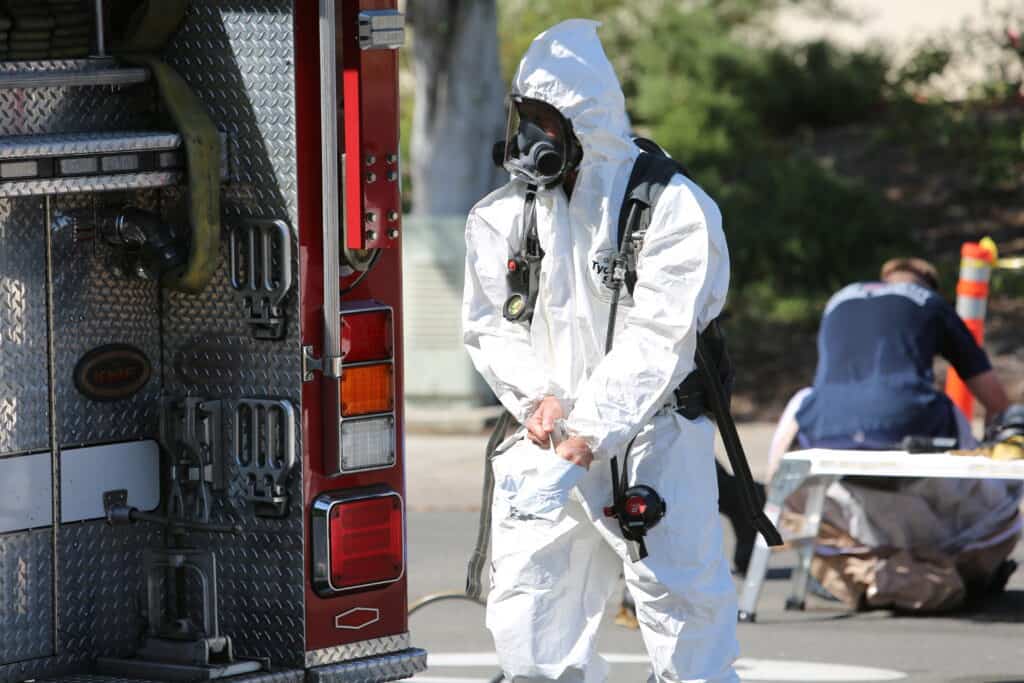Shelter-in-place drills are essential components of school safety programs, preparing students and staff for situations where staying inside the school building is the safest course of action.
One primary reason for these drills is to prepare for hazardous materials (hazmat) incidents, such as chemical spills or airborne toxic events.
Conducting these drills regularly helps ensure everyone understands the proper procedures to follow in case of real emergencies and reduces panic or confusion.
In Texas, for example, schools are required to conduct two shelter drills per year: one for shelter-in-place for hazmat situations and another for severe weather conditions.
These drills involve standardized, specific actions for all school staff and students, including relocation to specific areas in the building and practicing additional protective measures depending on the type of threat.
Schools need to coordinate with local authorities and emergency responders to ensure that their shelter-in-place plans are consistent with community-wide strategies regarding hazmat incidents.
This collaboration can help increase overall preparedness and facilitate efficient communication during a real event, allowing for a more effective response and quicker return to normal operations post-incident.
Overall, shelter-in-place drills play a critical role in maintaining the safety and well-being of students and staff during hazmat emergencies.
Understanding a School Shelter-in-Place Drill Hazmat
Shelter-in-Place Basics
Shelter-in-place drills are designed to protect students, staff, and visitors from potential hazards or threats such as hazardous materials (hazmat) incidents.
During a shelter-in-place drill, the school activates its emergency plan, and everyone inside the building is directed to designated safe areas.
The goal is to minimize exposure to the hazard and ensure everyone’s safety until the threat has passed or authorities have given the all-clear signal.
Hazmat Threats and Hazards
Hazmat incidents can occur due to various factors, such as chemical spills, gas leaks, or even acts of terrorism.
These incidents have the potential to cause severe health issues, property damage, and environmental harm.
Schools must have plans in place to address the specific needs and actions required to adequately protect their occupants during a hazmat-related shelter-in-place event.
This includes identifying safe rooms, establishing communication methods, and having a list of necessary supplies to sustain the individuals inside the shelter.
Difference Between Lockdown, Evacuation, and Shelter-in-Place Drills
Understanding the differences between lockdown, evacuation, and shelter-in-place drills is critical for effective emergency management in schools:
Lockdown
Lockdown drills are implemented when there is an immediate threat inside the school, such as an intruder or active shooter. Everyone is directed to lock doors, turn off lights, and remain silent and out of sight until the situation is resolved.
Evacuation
Evacuation drills involve the orderly exit of all building occupants in the event of fires, bomb threats, or other incidents that make staying inside the building unsafe. Students and staff follow predetermined routes to safety zones or assembly points outside the school.
Shelter-in-Place
Shelter-in-Place drills are implemented when there is a hazard or threat outside the school, such as hazardous materials or severe weather. The building is secured, and individuals are directed to safe areas within the school.
As we mentioned above, a school shelter-in-place drill for hazmat situations is focused on protecting students and staff from external hazards by keeping them in designated safe areas within the school.
Preparation and understanding of the differences between lockdown, evacuation, and shelter-in-place drills are crucial for ensuring the safety and well-being of everyone in the school community during emergencies.
Implementing Shelter-in-Place Hazmat Drills
Collaboration with Local Authorities and Emergency Management
It is essential to collaborate with local authorities and emergency management agencies when planning and implementing shelter-in-place hazmat drills in schools.
These agencies can provide expertise in handling hazardous materials incidents, understanding the Incident Command System (ICS), and implementing the Standard Response Protocol (SRP).
By working together, schools and emergency management professionals can develop effective precautions and response plans to ensure enhanced safety and protection during hazmat events.
Developing the Shelter-in-Place Annex
A crucial aspect of implementing shelter-in-place hazmat drills is the development of a comprehensive Shelter-in-Place Annex for the school’s emergency response plan.
This annex should include:
- Clearly defined roles and responsibilities for administrators, staff, and students.
- Identification of safe locations within the school for sheltering during a hazmat event, considering factors like ventilation systems and building materials.
- Procedures to seal off affected areas and prevent hazardous materials from infiltrating designated shelter locations.
- Communication protocols for notifying all school occupants of the shelter-in-place order, and for staying informed of updates from emergency management agencies.
- Plans for addressing the needs of individuals with disabilities and access or functional needs during shelter-in-place situations.
Training Staff and Administrators
Proper training of school staff and administrators is a vital component of effective hazmat response plans.
Staff may benefit from training in the following areas:
- Recognizing the signs and symptoms of a hazardous materials release, as well as understanding the potential risks associated with different types of hazardous substances.
- Familiarization with the school’s emergency response plan, specifically the Shelter-in-Place Annex.
- Safe operation of any specialized equipment or tools needed during shelter-in-place situations, such as portable radios or materials for sealing off doors and vents.
- Executing the appropriate response procedures for different hazmat scenarios, including steps to take after the immediate threat has passed.
By combining a thoughtful and thorough approach to planning, collaboration, and training, schools can effectively implement shelter-in-place hazmat drills, helping to ensure the safety and well-being of students, staff, and visitors during potentially dangerous hazmat incidents.
Conducting the Shelter-in-Place Hazmat Drill
Activating the Drill
To begin the shelter-in-place hazmat drill, a member of the school administration should activate the drill using a predetermined method known to staff and faculty.
This may include a specific announcement made over the public address system or sending out a mass notification through cell phones.
Securing the Building
Once the drill has been activated, school personnel should immediately take action to secure the building.
This will typically involve locking all doors and windows, turning off air conditioning or heating systems to avoid drawing in hazardous materials from outside, and closing any other openings that might allow contaminants to enter the building.
Each classroom should also be secured to ensure student safety.
Establishing Communication

During a shelter-in-place hazmat drill, establishing clear communication is essential.
School officials should make regular announcements over the public address system or through other communication methods such as cell phones, keeping staff, students, and parents informed of the situation.
Regular updates and clear instructions will help reduce panic and maintain order during the drill.
Providing Protective Supplies
In a real shelter-in-place hazmat situation, schools should have protective supplies on hand to help keep students and staff safe from hazardous materials. Supplies to consider stocking include:
- Duct tape: This can be used to seal gaps around doors, windows, and other openings.
- Plastic sheeting: Heavy-duty plastic sheeting is useful for creating a barrier to prevent hazardous materials from entering a room.
- Masks and gloves: These personal protective items can help prevent the spread of contamination when handling potentially infected items.
By incorporating these elements into the shelter-in-place hazmat drill, school officials can test their preparedness, identify areas that may need improvement, and ensure that students and staff know how to respond in the event of an actual hazmat emergency.
Choosing the Right Locations for Shelter-in-Place
When conducting a school shelter-in-place drill for hazmat situations, selecting the appropriate locations within the building is crucial.
Let’s look at a few recommended locations for shelter-in-place, including classrooms, the gymnasium, and interior rooms.
Classrooms
Classrooms are often the primary locations for shelter-in-place.
However, not all classrooms are suitable for this purpose.
In the event of a hazmat situation, it’s important to choose classrooms that:
- Are located on the highest floor possible to minimize contact with hazardous materials.
- Have few or no windows to prevent the entry of hazardous substances.
- Have exterior doors that can be sealed effectively to block out hazardous gasses and particles.
In addition, students should be instructed to stay away from windows and other openings during the drill.
Ensure proper ventilation systems are in place, which could prevent toxic fumes from entering the room during the shelter-in-place.
Gymnasium
A school’s gymnasium can serve as an alternative or supplemental location for shelter-in-place.
However, similar precautions must be taken to ensure the safety of students and staff:
- The gym must be located on the highest floor possible to minimize contact with hazardous materials.
- All doors and windows must be sealed effectively with materials such as plastic sheeting and duct tape.
- Ventilation systems should be turned off to prevent the entry of hazardous substances.
The gymnasium offers the advantage of a larger space that can accommodate more students, but it is essential to still follow proper safety protocols.
Interior Rooms
Interior rooms without windows are ideal locations for shelter-in-place during a hazmat situation.
These rooms may include storage rooms, offices, or bathrooms.
To maximize safety, choose interior rooms that:
- Are centrally located within the school building, as far away from exterior walls as possible.
- Have doors that can be effectively sealed using materials such as plastic sheeting and duct tape.
- Have no ventilation ducts leading to the outdoors.
Remember to include necessary supplies, such as water, food, and first aid kits, in these rooms to provide for the needs of students and staff during the shelter-in-place.
By selecting appropriate locations for shelter-in-place drills, schools can better prepare and protect their students and staff in the event of a hazmat emergency.
Dealing with Different Hazmat Scenarios
Schools should be prepared to deal with various hazardous material (Hazmat) scenarios during shelter-in-place drills.
This includes effectively managing different types of hazards, such as chemical, biological, and radiological contaminants.
Chemical Hazards
Chemical hazards involve substances that can cause harm to humans and the environment.
These can include industrial chemicals, pesticides, and toxic gases.
Schools should develop protocols for managing chemical hazards, such as:
- Identifying potential chemical hazards around the school, like nearby industries or highways.
- Training staff on how to detect and respond to chemical hazards.
- Equipping the school with appropriate protective gear and materials, such as gas masks and chemical-resistant clothing.
Biological Hazards
Biological hazards refer to microorganisms, such as bacteria, viruses, and other pathogens, which can cause illnesses or infections in humans.
To address biological hazards, schools should:
- Implement proper hygiene and sanitation measures to minimize the risk of infections.
- Train staff and students on proper hand-washing techniques and other preventive measures.
- Develop protocols for isolating affected individuals and notifying health authorities.
Radiological Contaminants
Radiological contaminants are materials that emit radiation, posing a risk to human health and the environment.
Schools must be prepared to handle radiological hazards by:
- Identifying potential sources of radiological hazards in the vicinity of the school, such as nuclear power plants or radioactive waste storage facilities.
- Training staff on proper procedures for detecting and responding to radiological incidents.
- Ensuring the school building is equipped with the necessary shielding materials to protect occupants from radiation exposure.
By addressing chemical, biological, and radiological hazards in their shelter-in-place drills, schools can better protect students and staff during Hazmat situations, ensuring a safer environment for all.
Duration and Frequency of Hazmat Drills

School Year Schedule
During the school year, schools need to implement a standard response protocol that includes conducting hazmat drills.
This helps staff and students become familiar with the proper procedures in case of a hazardous material incident.
Ideally, hazmat drills should take place at least once per semester to ensure the school community remains well-prepared.
The duration of a hazmat drill can vary, depending on the situation and specific hazard.
However, shelter-in-place activities typically do not exceed several hours.
Schools need to have a plan in place for a variety of potential hazards, as identified by the Multihazard Emergency Planning for Schools Toolkit.
Drill Documentation
Proper documentation is crucial for the success of a school’s hazmat drill program.
Schools must keep records of each drill conducted, including the date, time, duration, and specific hazard scenario.
It is also beneficial to document any challenges or issues encountered during the drill to help improve future exercises.
Keeping thorough drill documentation is essential not only to ensure regulatory compliance but also to enable the school to learn from past drills and continuously improve the effectiveness of its response protocol.
By adhering to a regular schedule of hazmat drills throughout the school year and keeping comprehensive documentation, schools can ensure that staff and students are well-prepared for any hazardous material incidents that may occur, thereby enhancing the safety and security of the school community.
Adapting to Other Emergency Scenarios
School shelter-in-place drills primarily focus on preparing for hazmat incidents.
However, it is essential to adapt emergency plans to address other potential threats like violence and active threats, severe weather, and earthquakes and tsunamis.
Violence and Active Threats
When facing violence or an active threat, it is vital to have an emergency plan in place that includes lockdown drills.
A lockdown may involve students and staff locking the door, turning out the lights, and hiding away from windows.
Communication is crucial during these situations, so ensuring everyone understands their role, including visitors, can greatly enhance safety.
In the event of explosions or other unexpected incidents, evacuating the building may be necessary.
Conducting evacuation drills will help ensure everyone knows where to go, reducing the risk of panic and confusion during a real emergency.
Severe Weather
Severe weather can include tornadoes, extreme wind, and hurricanes.
Each presents unique challenges that require specific precautions.
An emergency plan should involve tornado and severe weather drills to ensure students and staff know what to do.
The general procedure for tornadoes is to have people take shelter in interior, windowless rooms on the lowest level of the building.
Schools in hurricane-prone regions should be prepared to evacuate when necessary, while also considering proper closure procedures to maximize safety for everyone involved.
In extreme wind situations, taking shelter in designated safe rooms can help protect occupants.
Earthquakes and Tsunami
In earthquake-prone areas, schools must incorporate “drop, cover, and hold” drills into their emergency plans.
This technique involves finding cover under a sturdy piece of furniture, such as a desk, and holding onto it until the shaking stops.
After an earthquake, the risk of a tsunami might arise – especially in coastal regions.
A well-rounded emergency plan must include plans for both evacuation and sheltering in case of a tsunami.
Knowing when to evacuate and the designated evacuation routes will help ensure everyone reaches safety as quickly as possible.
Adapting school shelter-in-place drills to address various emergency scenarios is essential for promoting safety and preparedness.
By incorporating specific drills, such as lockdowns for violence and active threats, tornado and severe weather drills, and earthquake and tsunami drills, schools can better protect their students, staff, and visitors.
Final Thoughts
A school’s ability to effectively respond to hazardous materials incidents is crucial for ensuring the safety of students and staff.
One essential component of emergency preparedness is conducting shelter-in-place drills for Hazmat situations.
These drills serve the purpose of familiarizing students and staff with protective actions to take during an actual event.
In Texas, for example, schools are required to hold two shelter drills per year, one of which specifically focuses on shelter-in-place for Hazmat situations.
By rehearsing these drills regularly, school communities develop a heightened level of awareness and readiness for potential hazards.
The FEMA Multihazard Emergency Planning for Schools Toolkit provides resources and guidelines for developing standardized actions during various emergencies, including Hazmat incidents.
Utilizing such tools can greatly improve a school’s ability to effectively shelter in place during an actual hazardous materials release.
Furthermore, schools should not only conduct regular drills but also evaluate their effectiveness regularly.
Debriefing sessions should follow drills to identify areas for improvement, discuss any challenges faced, and suggest solutions.
This continuous improvement process will ensure that the school community is well-prepared to respond to Hazmat situations with confidence.
In summary, regularly practicing shelter-in-place drills for hazardous materials incidents remains a vital component in maintaining safety in educational environments.
By utilizing available resources, and regularly evaluating, and refining their procedures, schools can significantly improve their preparedness and ability to protect their students, faculty, and staff from potential hazards.






